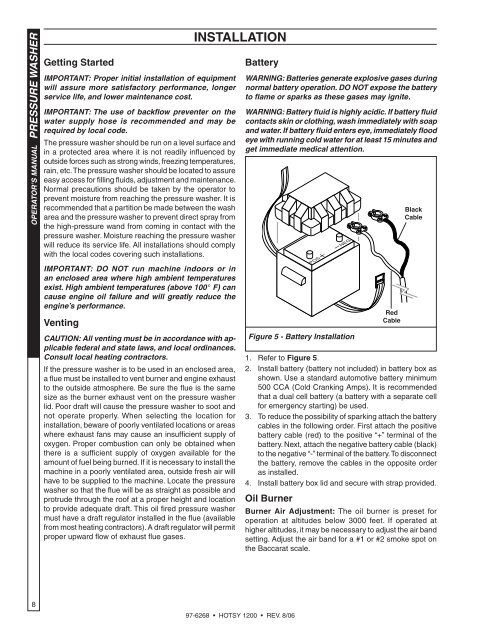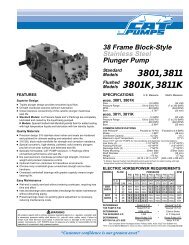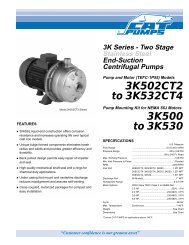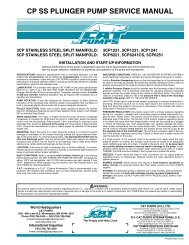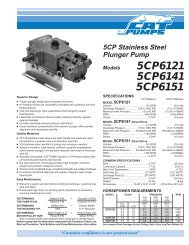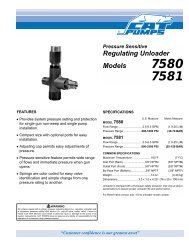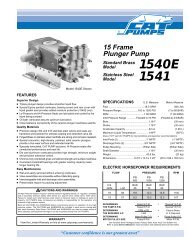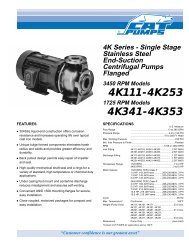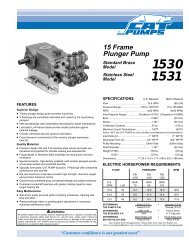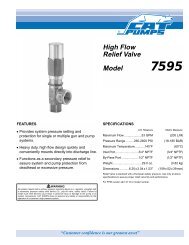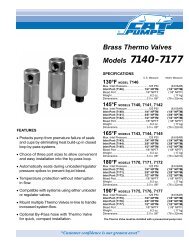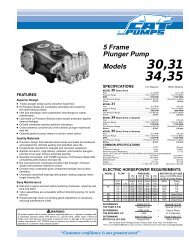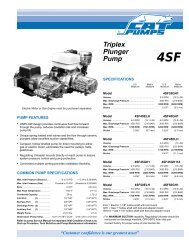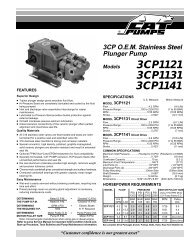Hotsy 1200 97-6268 0608 - ETS Company Pressure Washers and ...
Hotsy 1200 97-6268 0608 - ETS Company Pressure Washers and ...
Hotsy 1200 97-6268 0608 - ETS Company Pressure Washers and ...
Create successful ePaper yourself
Turn your PDF publications into a flip-book with our unique Google optimized e-Paper software.
OPERATOR’S MANUAL PRESSURE WASHER<br />
8<br />
Getting started<br />
IMPORTANT: Proper initial installation of equipment<br />
will assure more satisfactory performance, longer<br />
service life, <strong>and</strong> lower maintenance cost.<br />
IMPORTANT: The use of backflow preventer on the<br />
water supply hose is recommended <strong>and</strong> may be<br />
required by local code.<br />
The pressure washer should be run on a level surface <strong>and</strong><br />
in a protected area where it is not readily influenced by<br />
outside forces such as strong winds, freezing temperatures,<br />
rain, etc. The pressure washer should be located to assure<br />
easy access for filling fluids, adjustment <strong>and</strong> maintenance.<br />
Normal precautions should be taken by the operator to<br />
prevent moisture from reaching the pressure washer. It is<br />
recommended that a partition be made between the wash<br />
area <strong>and</strong> the pressure washer to prevent direct spray from<br />
the high-pressure w<strong>and</strong> from coming in contact with the<br />
pressure washer. Moisture reaching the pressure washer<br />
will reduce its service life. All installations should comply<br />
with the local codes covering such installations.<br />
IMPORTANT: DO NOT run machine indoors or in<br />
an enclosed area where high ambient temperatures<br />
exist. High ambient temperatures (above 100° F) can<br />
cause engine oil failure <strong>and</strong> will greatly reduce the<br />
engine’s performance.<br />
venting<br />
CAUTION: All venting must be in accordance with applicable<br />
federal <strong>and</strong> state laws, <strong>and</strong> local ordinances.<br />
Consult local heating contractors.<br />
If the pressure washer is to be used in an enclosed area,<br />
a flue must be installed to vent burner <strong>and</strong> engine exhaust<br />
to the outside atmosphere. Be sure the flue is the same<br />
size as the burner exhaust vent on the pressure washer<br />
lid. Poor draft will cause the pressure washer to soot <strong>and</strong><br />
not operate properly. When selecting the location for<br />
installation, beware of poorly ventilated locations or areas<br />
where exhaust fans may cause an insufficient supply of<br />
oxygen. Proper combustion can only be obtained when<br />
there is a sufficient supply of oxygen available for the<br />
amount of fuel being burned. If it is necessary to install the<br />
machine in a poorly ventilated area, outside fresh air will<br />
have to be supplied to the machine. Locate the pressure<br />
washer so that the flue will be as straight as possible <strong>and</strong><br />
protrude through the roof at a proper height <strong>and</strong> location<br />
to provide adequate draft. This oil fired pressure washer<br />
must have a draft regulator installed in the flue (available<br />
from most heating contractors). A draft regulator will permit<br />
proper upward flow of exhaust flue gases.<br />
installation<br />
battery<br />
<strong>97</strong>-<strong>6268</strong> • HOTSY <strong>1200</strong> • REV. 8/06<br />
WARNING: Batteries generate explosive gases during<br />
normal battery operation. DO NOT expose the battery<br />
to flame or sparks as these gases may ignite.<br />
WARNING: Battery fluid is highly acidic. If battery fluid<br />
contacts skin or clothing, wash immediately with soap<br />
<strong>and</strong> water. If battery fluid enters eye, immediately flood<br />
eye with running cold water for at least 15 minutes <strong>and</strong><br />
get immediate medical attention.<br />
Figure 5 - Battery Installation<br />
1. Refer to figure 5.<br />
2. Install battery (battery not included) in battery box as<br />
shown. Use a st<strong>and</strong>ard automotive battery minimum<br />
500 CCA (Cold Cranking Amps). It is recommended<br />
that a dual cell battery (a battery with a separate cell<br />
for emergency starting) be used.<br />
3. To reduce the possibility of sparking attach the battery<br />
cables in the following order. First attach the positive<br />
battery cable (red) to the positive “+” terminal of the<br />
battery. Next, attach the negative battery cable (black)<br />
to the negative “-” terminal of the battery. To disconnect<br />
the battery, remove the cables in the opposite order<br />
as installed.<br />
4. Install battery box lid <strong>and</strong> secure with strap provided.<br />
oil burner<br />
red<br />
cable<br />
black<br />
cable<br />
burner air adjustment: The oil burner is preset for<br />
operation at altitudes below 3000 feet. If operated at<br />
higher altitudes, it may be necessary to adjust the air b<strong>and</strong><br />
setting. Adjust the air b<strong>and</strong> for a #1 or #2 smoke spot on<br />
the Baccarat scale.


